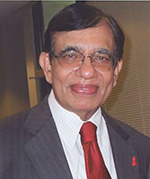
Cancer – What’s the Answer? Part IV

Early detection is key
The good news is President Biden has renewed his pledge to end cancer as we know it. He said recently, “We will bring a fierce sense of urgency to the fight against cancer,” a welcome revival of the ‘moon shot’ – an initiative, first launched in 2016 when Biden was vice president. This aims to accelerate the progress of cancer research in the U.S. that includes early detection, proper screening and state-of-the-art therapy. To detect every cancer as early as possible, one needs to know its symptoms that you cannot afford to neglect. First, let me give you some real-life stories.
A 56-year-old woman began experiencing back pain, which she initially thought was job-related, being a secretary with a desk job and constantly crouched in front of the computer. Since Tylenol and back exercises didn’t help, she saw her family doctor who took a spine X-ray that already showed tell-tale signs of bone metastasis from a primary kidney tumor! An oncologist told me that he was saddened to see a middle-aged lady with advanced breast cancer in his clinic recently. “I felt a tiny nodule, more like a peanut a year ago. I thought it will go away but then it grew and grew,” she said. Precious time was lost in treating and even curing her disease. But the case of Mr. Henry, one of my patients, had a happy ending. When he presented with a little chest pain and mild cough, he was immediately sent for a chest X-ray, being an ex-smoker, and it showed a small but abnormal opacity in the right upper lung that turned out to be cancer. With surgery followed by adjunct therapy from the oncologist, he remained cancer-free for many years.
Initial symptoms of an underlying cancer can vary depending on the size of the tumor and organ affected. If it has spread (metastasized) to other organs as they often do, then you can expect additional symptoms related to the dysfunction of the affected part. Which is what happened to our first patient whose kidney tumor was not diagnosed early enough. Also, an enlarging tumor can compress the nearby structures producing symptoms related to the pressure effect on that organ. Like an enlarging ovarian tumor in the pelvis that pushes the bladder causing urinary symptoms. A large pancreatic tumor, often painless, can compress the bile duct to cause jaundice.
In general, if a patient experiences unexplained weight loss, lack of appetite, fever of unknown origin that refuses to go away, general fatigue, recurrent cough, constant body aches or skin changes that do not heal properly, a thorough investigation is warranted. Then there are specific symptoms related to the primary organs affected. A tumor in the colon is often associated with constipation and blood in the stools. And those who develop urinary bladder cancers invariably present with episodes of hematuria (blood in the urine). A brain tumor patient often complains of headaches and uterine cancers typically produce vaginal bleeding. If a patient develops a nagging cough or hoarseness of voice, one should suspect a cancer of the larynx or a thyroid tumor that can compress the voice box. Any thickening or even a tiny lump in the breast needs immediate work-up to rule out breast cancer. A change in the size of a wart or mole or occurrence of additional symptoms like itching or slight bleeding on the previously benign- looking skin lesion should immediately alert attention that the lesion is growing and may have become cancerous. Children are more commonly affected by blood cancers such as leukemia and lymphomas. And they may not often voice many complaints. But if you note the child is lethargic, has frequent nose bleeds, easy bruising, looking paler and has fever, etc., full work-up is needed.
Then there are symptoms, which are considered a remote effect of the tumor (not related to involvement of any organ), perhaps a humoral or hormonal effect? This is particularly true with lung cancers. Some people exhibit high calcium levels in the blood or tend to develop hypoglycemia or low sugar in the blood. Pancreatic cancers can produce thrombophlebitis or venous clotting in the legs.
The key to cure or at least long-term survival from cancer depends how early the disease can be diagnosed and how quickly the right treatment can be instituted. A delay in diagnosis is the commonest cause for the high death rate from cancer. Hence, pay close attention to any kind of abnormal or unusual symptoms that you are experiencing and make an appointment with your doctor right away.
...This series will continue next month.
M.P. Ravindra Nathan, M.D., is a cardiologist and Emeritus Editor of AAPI Journal. For further reading, “Second Chance - A Sister’s Act of Love” by Dr. Nathan from Outskirts Press, can be found at www.amazon.com
EYE CARE

In time for and beyond Valentine’s: VUITY eye drops
You can now look into your sweetheart’s eyes at close distance without pesky reading glasses in between.
The U.S. Federal Drug Administration recently approved Vuity™ prescription eye drop to treat age-related blurry near vision called presbyopia in adults. In FDA studies, improved near vision was noted without compromising distance vision.
What is amazing is that this eye drop has a main ingredient that has been around for over a century (Pilocarpine), which by constricting the pupil of the eye increases the depth of focus like a camera.
First let’s understand what is presbyopia (previous Khaasbaat article). Most people will end up needing reading glasses as we ‘mature” into our 40s. So, put on your “cheaters” and read on.
In a young eye (less than about 40 years old), the lens is fully transparent and flexible. The lens muscles can easily change its curvature from steeper to flatter and give you clear vision at all distances. But during middle age, usually beginning in the early 40s, the lens becomes less able to change shape, so people experience blurred vision at near points, such as reading, sewing or working at the computer and smart phones. This is known as presbyopia.
I like to describe this mechanism as an age-related loss of “zooming power” (“tele & wide,” like a camera) of your natural lens inside the eye (hence you zoom with your arms – short hands syndrome).
Given time, presbyopia happens to everyone. Also, you can have other conditions (like cataracts, nearsightedness and farsightedness) and presbyopia at the same time. In fact, you can even have 20/20 vision, but still need reading glasses because of presbyopia.
Vuity is the first and only FDA-approved prescription eye drop for treatment of presbyopia in adults and helps patients read and see up close while maintaining distance vision. The recommended dose is a single drop once daily in each eye. If more than one topical eye medication is being used, administer at least five minutes apart.
In studies, the eye drop improved near vision without compromising distance vision. This was measured by the proportion of patients achieving a three-line gain or more reading a near-vision eye chart without losing more than a line in a distance vision eye chart at day 30, three hours after dosing. It does require a prescription.
This medication eye drop should be used with caution during night driving and other hazardous activities, such as in poor light. Temporary snags when changing focus between near and distant objects may occur. Do not drive or use machinery if your vision is not clear. The most common side effects were headache and eye redness.
I personally see the importance of the drop not only to help people see up close but, in fact, do so in a safe, reversible and temporary way. It can also be a bridge for patients awaiting to undergo surgery for presbyopia.
I have previously described advanced laser techniques and multifocal cataract surgeries to correct presbyopia permanently and effectively, including associated cataracts, near- or farsightedness and even astigmatism.
As I returned after teaching at the world conference, it was great to see the eye care industry reveal a full pipeline of similar eye drop products to address this important vision problem that eventually everyone will face with age.
So finally, you have a reversible, safe and temporary way to read and see up close and impress people, especially with those menu cards in a dim-lit restaurant while your peers raise flashlights on their phones in embarrassment.